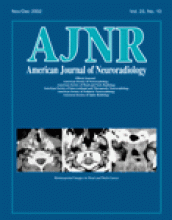Intravertebral clefts have been radiographically recognized for decades, appearing traditionally as a vacuum or air-filled cleft inside a vertebral body and usually associated with previous fracture. This cleft was presumed to represent a sign of avascular necrosis or nonunion and at times could be associated with visible motion when viewed fluoroscopically (1). With the advent of MR imaging, the clefts seen radiographically have been correlated with high signal intensity on T2-weighted MR images in the location of the cleft (2). It was thought that the MR imaging was detecting fluid within the cleft, and some authors described a radiographic change in the appearance of the air-filled cleft over time with the air being replaced by some type of fluid when the patients were positioned supine (3).
Percutaneous vertebroplasty has been used since 1984 to treat the pain resulting from vertebral compression fractures resulting from osteoporosis or neoplastic invasion. Authors have previously listed avascular necrosis or Kummell’s disease as a treatable cause of pain observed in some cases of compression fracture. These were identified usually as having an air-filled cleft, and some were noted to show motion fluoroscopically (4). Motion has been associated with a high probability of severe, persistent pain and very good result with percutaneous vertebroplasty. Pain relief was thought to be due to the elimination of excessive motion after cementing. Often, these patients described pain relief immediately after the procedure. These cases represented a small percentage of the patients evaluated and treated with percutaneous vertebroplasty. Nevertheless, the motion during fluoroscopy and the rapid recovery after percutaneous vertebroplasty make these patients interesting and notable.
High signal intensity zones observed within fractured vertebrae on MR images may represent fluid. This is commonly seen in sub-end plate regions after fracture and less often in the central vertebra marrow space. Some authors have suggested that this may represent the same pathologic entity as air-filled clefts seen on radiographs. Data are available to indicate that this is true in at least some of the cases (3). The MR imaging data are not, however, well correlated with the pathologic findings, and the presumption that all these situations represent the same pathologic cause is not well established.
In this issue of the AJNR, Lane et al describe their findings and the results achieved when attempting to treat “intravertebral clefts” with opacification during percutaneous vertebroplasty. This is a retrospectivereview and has all the usual built-in problems associated with this type of data analysis. Their longest follow-up period includes only 40% of the patients compared with the starting population. They not only lump together patients with radiographic and MR imaging evidence of vertebral cleft (for which there is some support in the literature, albeit inconclusive) but also patients who seem to have clefts after percutaneous vertebroplasty that were not shown on images obtained before percutaneous vertebroplasty. In almost 36% of the cases designated as including clefts in this article, the clefts were found only after percutaneous vertebroplasty was performed; these were considered to be clefts, without any pathologic proof or previous literature evidence that this is correct.
The authors found that patients with “intravertebral clefts” responded in a similar manner as did patients with compression fracture without clefts. There was no statistical difference at any reference point in their data (although they suggest a trend to better outcome in the cleft population during long-term follow-up). There is a small population of patients who had clefts seen on the initial images that were not filled with cement during percutaneous vertebroplasty. These had a poor long-term pain response, suggesting that when a cleft is identified, it should be filled for dependable pain relief.
The results presented in this article are disappointing. Most physicians with substantial experience with percutaneous vertebroplasty would expect a better outcome differentiation between patients with proven intravertebral clefts than those without. It may be that this article does not show that expected difference because it does not exist or because the population chosen for analysis did not actually represent a homogeneous pathologic population. The presumption that clefts found only during percutaneous vertebroplasty are equivalent to those seen on imaging studies prior to vertebroplasty is certainly suspect and possibly inaccurate. Further pathologic data examining these suspected clefts are needed before a firm conclusion can be reached regarding this part of the authors’ grouping. Even the suspected clefts in the remaining population, as revealed with both MR imaging and radiography, could be the result of different pathologic processes and could respond variably to percutaneous vertebroplasty.
It does seem evident that when one sees an intravertebral cleft shown by MR imaging or radiography (before percutaneous vertebroplasty), an effort should be made to fill the cleft with bone cement. This usually occurs regardless of where the needle is placed in the vertebral body. Even with the needle placed away from the cleft, cement will usually track to the cleft and fill the region, because there is little resistance to flow into the rarefied zone. In the rare case in which this does not occur, repositioning the needle or repeat injection may be indicated to ensure a final fill that is biomechanically stable and results in good pain relief.
- Copyright © American Society of Neuroradiology











